

| Part III. | ODA DISBURSEMENTS IN FISCAL YEAR 2002 |
As Japan regarded human resources development as a foundation
for nation building, assistance for basic education is an area in which Japan
can utilize its experience in education. Japan has been making concrete efforts
in this area of cooperation with the concerned organizations, primarily the
Ministry of Foreign Affairs (MOFA), the Ministry of Education, Culture, Sports,
Science and Technology (MEXT), and Japan International Cooperation Agency (JICA).
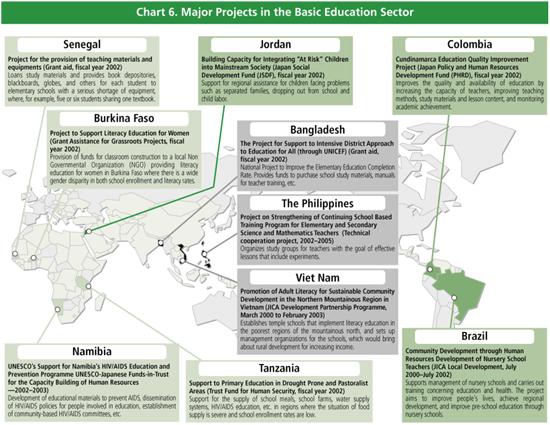 |
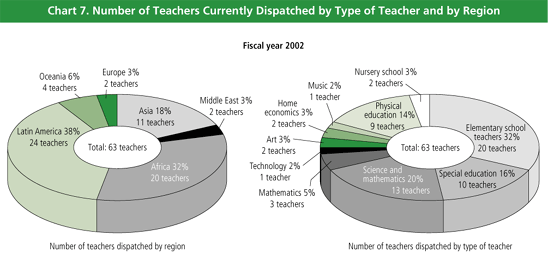 |
Japan is strengthening its cooperation in the area of basic education
based on the Basic Education for Growth Initiative (BEGIN), which was announced
in 2002. The BEGIN states three priority areas for Japan’s assistance in
primary education: (1) ensuring “access” to education; (2) improving
“quality” of education; and (3) improving “management” of
education.
Concerning “access” to education, Japan is contributing to improvement
of children’s access to education and educational environment through construction
and refurbishment of educational facilities and provision of study materials,
etc. for primary and secondary education. The main form of this cooperation
is grant aid. Specifically, in fiscal year 2002, approximately 550,000 children
worldwide—300,000 in Asia and 230,000 in Africa—benefited from school
construction, distribution of study materials, and provision of classroom equipment
by Japan.
With regard to improving the “quality” of education, Japan is supporting
scientific and mathematical education and improvements of school management
capacity. Judging from Japan’s experience in education, the benefits of
education, including science and mathematics, depend especially on the capacity
of teachers, therefore, Japan is placing priority on teacher training, improving
teaching methods, and developing study materials. Japan’s support for these
areas including scientific and mathematical education has been developed actively
since the 1990s and it has become one of the characteristics of Japan’s
support. For example, since 1998, through the “Strengthening of Mathematics
and Science in Secondary Education (SMASSE)” Project, Japan has been providing
training at central and regional levels for incumbent teachers in nine out of
the seventy-one provinces in Kenya. This project has been recognized in the
field of education as a project aiming at a shift from “teacher centered
to student focused classroom practice,” and has also been praised by the
Government of Kenya, which has set a goal of achieving industrialization by
2020, as a project which is contributing to the human resources development
that is essential for industrialization. These experiences and results in Kenya
attracted the attention of neighboring African countries and by the initiative
of the Kenyan Ministry of Education, Science and Technology, a network for scientific
and mathematical education was launched in June 2002 among educational administrators
in 13 African countries. Moreover teachers are contributing to improving the
quality of education in developing countries throughout the world by utilizing
their own experience. For example, through the Japan Overseas Cooperation Volunteers
(JOCV) “Participation system for incumbent teachers” was established
in fiscal year 2001, 63 incumbent teachers were dispatched to developing countries
in fiscal year 2002 and an additional 56 incumbent teachers are going to be
dispatched in fiscal year 2003.
Along with support for improvements to “quality,” improvements of
“management” is one area where Japan can utilize its own education
experience to contribute to development of education in developing countries,
and Japan is providing support for the formulation of education policies and
education plans and for improvements of education administration systems. For
Malawi, Japan implemented the “National Regional Education Support Plan
Formulation Study” for two years from 2000, carried out school mapping,
studies and analyses of educational conditions, and used all this information
to formulate educational development plans on a per-province basis. Through
these development studies, a wide group of people including local communities
as well as people involved in education in Malawi, participated in the planning
process to realize these plans and these measures are expected to develop throughout
the country.
With goals to maintain and expand cooperation in these sectors and to undertake
measures in sectors with little experience of assistance, Japan, primarily through
MEXT, is working to develop domestic institutions such as the “cooperation
bases system,” *1 etc.
The launching of the “cooperation bases system” was incorporated in
the final report of Committee for International Cooperation in Education submitted
in July 2002 by then Minister of Education, Culture, Sports, Science and Technology
Atsuko Toyama, and the system is planned to be inaugurated in fiscal year 2003.
Among these three priority sectors, the support for “access” to education,
which is focused on school construction, accounts for approximately over 70%
of the entire budget in support for the basic education sector in Japan. Currently,
developing countries are facing a wide range of needs in the primary education
sector, including the need to overcome the shortage of teachers, teacher capacity
development, curriculum improvement, HIV/AIDS education, etc. How to expand
support in these “soft” sectors is the future issue. When doing so,
Japan believes that promoting not only the involvement of the administrative
side but also the participation of children’s parents and the community
is an essential element for realizing the benefits of assistance in a more sustainable
and effective manner.
In many developing countries, many people are still suffering
because they are unable to receive the basic health and medical services that
can be easily accessed in developed countries. There are three goals in the
health field related to the Millennium Development Goals (MDGs): reduce child
mortality, improve maternal health, and combat HIV/AIDS, malaria and other infectious
diseases. Importance is placed on these three goals related to poverty reduction.
Japan provides assistance in the health sector, which places priority on the
issues of infectious diseases, mother and child health, and the development
of the health system.
Infectious diseases are not only a health issue posing a
threat to the lives of individuals in developing countries, but also they are
currently becoming a major factor hindering the economic and social development
of these countries. In this regard, Japan announced the Okinawa Infectious Diseases
Initiative (IDI) at the G8 Kyushu-Okinawa Summit in July 2000 and has been taking
comprehensive measures to combat infectious diseases under this initiative.
Refer to the following link to the section on
Japan’s responses to global issues for an explanation on Japan’s efforts
to combat infectious diseases (Infectious Diseases).
Together with developing measures to combat infectious disease and health systems,
Japan supports mother and child health as the priority issue in the health sector
because it is women and children who are most vulnerable in poverty. Japan is
mainly providing assistance for children’s health, maternal health and
reproductive health2. Support for reproductive
health is also an important approach in responding to the population issue,
one of the global issues. In addition to direct cooperation in population and
family planning efforts, Japan has been taking a comprehensive approach to indirect
cooperation like health and medical care, basic education for girls, and Women
in Development (WID)/gender, etc.
With respect to support for children, Japan is supporting the provision of vaccines,
because diseases such as polio, measles, tetanus, etc. which can be fatal to
infants can often be prevented through relatively inexpensive interventions
such as vaccinations, etc. Concerning polio, which has serious sequelae, Japan
is actively working towards polio eradication through polio immunization activities,
in cooperation with the United Nations Children’s Fund (UNICEF) and the
World Health Organization (WHO). In fiscal year 2002 Japan provided support
for “The Project for the Eradication of Poliomyelitis” (provision
of polio vaccines) in India, Pakistan and Bangladesh; “The Project for
the Construction of the Facilities for Measles Vaccine Production” in Viet
Nam; “The Project for Infectious Disease Prevention for Children”
(provision of polio and measles vaccines) in Afghanistan, Sudan, Democratic
Republic of Congo, Ethiopia and Nigeria, and other projects.
| Column 1 | Introduction of Maternal and Child Health (MCH) Handbooks in Indonesia | ||||
|
Despite the recent downward trend in maternal mortality
and infant mortality ratios in Indonesia, they remained high with 226
maternal deaths (per 100,000 births) and 42 infant deaths (per 1,000
births) in 2002. (Three maternal deaths per 100,000 births and 9 infant
deaths per 1,000 births in the case of Japan.) In order to ensure safe
delivery and healthy growth of children, it is essential to enhance
maternal and child health services. In addition, improving maternal
health and reducing child mortality are incorporated in the MDGs.
|
|||||
Concerning reducing the maternal mortality ratio, Japan has provided steady
assistance based on reproductive health needs. This assistance includes the
project in Indonesia to disseminate mother and child handbooks applying Japan’s
experience in mother and child health, to develop capacity building of midwives
and nurses in mother and child health services, and the promotion of family
planning and sex education. However, in order to directly reduce the maternal
mortality ratio, it is necessary to provide appropriate medical care services,
including emergency obstetric care systems. Reducing the maternal mortality
ratio is the most difficult of the three MDGs in the health sector to achieve.
For this reason, internationally there is a movement, led by UNICEF, to concentrate
its assistance on the development of emergency obstetric care services. Taking
this movement into account, Japan is providing assistance in this sector in
collaboration with UNICEF, the United Nations Population Fund (UNFPA) and the
International Planned Parenthood Federation (IPPF, an international NGO). In
fiscal year 2002, Japan implemented the “Reproductive Health Project”
(strengthening of health administration for maternal care) in Viet Nam, the
“Project for Human Resources Development in Reproductive Health” (human
resources development in the mother and child health sector) in Bangladesh,
the “Strengthening Reproductive Health Education” project (human resources
development, development of audio-visual education, development of statistical
data) in Tunisia, the “Project for Support to Strengthening of Emergency
Obstetric Care Service” (provision of medical equipment) in Bangladesh,
the “Projet d’amelioration des soins de sant maternelle en milieu
rural” (construction of obstetrics-related facilities, provision of medical
apparatus and instruments) in Morocco, and other projects. Japan has contributed
¥4.9 billion to UNFPA and ¥1.9 billion to the IPPF respectively to prevent
HIV/AIDS and to support reproductive health programs.
Measures in the infectious diseases and mother and child health sector will
not achieve sufficient results if an appropriate health and medical care system
is not put in place for the entire country. In the international community,
direct measures to combat diseases, for example policies to combat HIV/AIDS
are focused upon, while Japan stresses that the establishment of a primary health
care system in a developing country plays an extremely important role in in
addition to the direct interventions to combat diseases. Therefore, Japan is
supporting the strengthening of community health, medical care and prevention
activities and the development and reform of nationwide health systems—the
development of adequate health and medical care systems in developing countries,
the capacity building of the personnel in health and medical care, and the development
of health and medical care related infrastructure—from the perspective
of “primary health care”—the perspective of providing basic health
and medical care services equally to a greater number of people.
In fiscal year 2002, in addition to dispatching experts to Pakistan for the
strengthening of health administration, Japan supported health projects such
as the “Strengthening District Health Services Project in Morogoro State”
(strengthening the managerial capacity of the health administration at the state
level) in Tanzania, the “Project for the Development of Human Resources
in Health” (increasing the quantity and improving the quality of education
for health workers and medical practitioners) in Senegal, and the “Lusaka
District Primary Health Care Project” (establishment of a primary health
care project management institution run by citizens’ organizations and
health center employees) in Zambia.
Concerning assistance in the health sector, which is closely related to the
poverty reduction, Japan promotes collaboration with a wide range of international
partners, starting from political dialogue, planning through to implementation,
monitoring and evaluation.
Concerning collaboration with NGOs, MOFA and health-related Japanese NGOs hold
informal consultations on a regular basis to exchange views and information,
and MOFA commissions NGOs to conduct surveys and studies that contribute to
the implementation of assistance.
Concerning relations with UNICEF, since the beginning of the 1990s Japan has
been cooperating with it to eradicate polio but in recent years Japan has widened
its cooperation with UNICEF to include sectors such as vaccinations for children’s
infectious diseases such as measles, tetanus, etc., provision of drugs to treat
malaria and mosquito nets, and the provision of safe water.
In relations with the United States (US), the “United States Agency for
International Development (USAID)-Japan Partnership for Global Health”
was announced in June 2002 and cooperation to improve the level of health and
medical care in developing countries is being advanced by Japan together with
USAID. They are cooperating on Voluntary Counseling and Testing (VCT) activities
(voluntary HIV counseling and medical tests) in Kenya, HIV prevention activities,
etc. in the border areas of Tanzania, and other projects throughout Africa,
Asia and Latin America. JICA and USAID are also carrying out personnel exchanges.
Of the people living in poverty in the world, approximately 70%
are women.3 In a variety of respects many women are placed in disadvantageous
positions. In order to realize balanced and sustainable development, it is necessary
to strive for the balanced participation of men and women in development and
the distribution of the benefits derived from development, so it is important
to make considerations for WID and gender equality.
In implementing ODA, Japan has been giving consideration to achieving women’s
empowerment and gender equality encompassing all stages of women’s lives,
and actively provided support with a focus on women’s education, health,
economic and social participation, in line with the “Japanese Initiative
on Women In Development (WID)” announced in 1995. Many projects related
to WID are technical cooperation projects such as the dispatch of experts and
the acceptance of trainees, and small-scale grant aid projects rooted in regions
through NGOs. Disbursements in fiscal year 2002 were approximately 11% of total
disbursements for technical cooperation, and approximately 25% of total disbursements
for grassroots human security grant aid. And as more importance is being placed
on consideration for gender in development in recent years, the Government of
Japan will make efforts not only WID, but all ODA projects are making further
considerations of social aspects including the perspective of gender equality.
Major efforts in this area include the following. In the reconstruction assistance
package Japan announced at the International Conference on Reconstruction Assistance
to Afghanistan in January 2002, one of the priority areas was “the advancement
of the status of women and their participation in nation-building” and
importance was placed on the participation of women in the post-conflict peace
process. In Afghanistan women’s freedom was extremely limited under the
Taliban regime, years of war and conflict produced many refugees and internally
displaced persons (IDPs), and many men died in the conflict resulting in many
widows and orphans, and the aging of society. All of this has made women’s
lives extremely difficult. So for these reasons too, women have an essential
role to play in reconstruction. Japan held the “Advisory Council on Assistance
to Women in Afghanistan,” hosted by Chief Cabinet Secretary Yasuo Fukuda,
beginning in February 2002, and the Council compiled the proposal entitled “Japanese
Assistance to Women in Afghanistan” in May. This proposal included basic
concepts, strategies, and description of possible projects, to advance Japan’s
support for women. Taking into account this proposal, Japan is actively supporting
women in Afghanistan through a number of projects, such as dispatching experts
on gender to the Ministry of Women’s Affairs of Afghanistan, accepting
trainees from the ministry, rehabilitation schools for girls, constructing women’s
community centers through NGOs, and supports for refugee and internally displaced
women (vocational and skills training, a wide range of seminars, income creation
projects) through the Trust Fund for Human Security.
Japan is also actively cooperating to support women in Cambodia where the civil
war of many years finally came to an end in 1991. Since 1996 Japan has dispatched
experts on several occasions to the Ministry of Women’s and Veterans’
Affairs of Cambodia. In future too, Japan will continue to dispatch experts
and provide equipment so that gender-related policies will be formulated by
the Ministry of Women’s and Veterans’ Affairs based on accurate gender
related information and statistical analyses both within and outside Cambodia
and these policies can be implemented effectively, including by the women’s
affairs bureaus of local governments.4
As one specific case study where Japan’s assistance led to a promotion
of the ownership of the developing country, beginning in 1999 Japan dispatched
experts to the Government of Indonesia as policy advisors on WID and gender
mainstreaming. One of the activities of these experts was to cooperate in the
development of gender statistics. As a result, JICA and the State Ministry for
Women’s Empowerment of Indonesia itself cooperated to compile provincial
gender statistical profiles5 for approximately 30 provinces and distributed
from 500 to 1,000 copies of these profiles to each province.
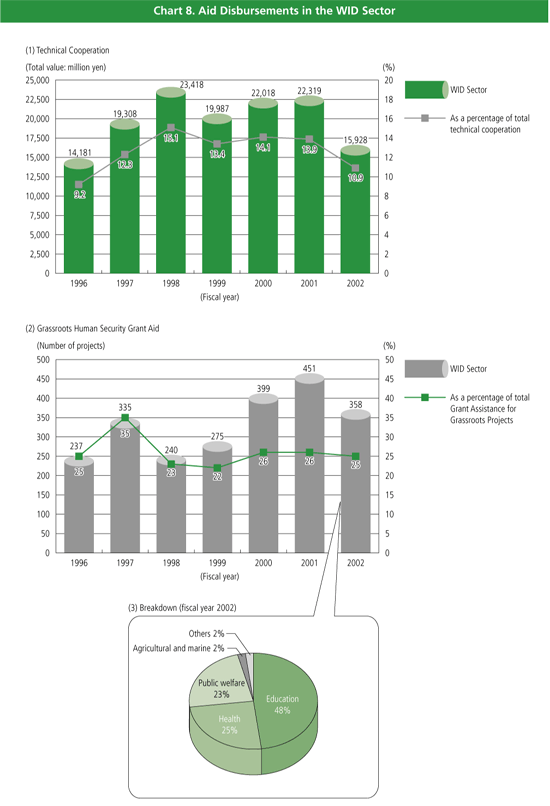 |
And seminars concerning the gender statistics were held in 12 provinces with
the participation of 80–100 people per province with the total number of
participants exceeding 1,000 people. The State Ministry for Women’s Empowerment
is aware of the importance of the gender statistics and after the JICA support,
it carried out budget allocations and personnel deployments to independently
publish gender statistical profiles. Some district governments have also published
their own gender statistics.
In addition, in fiscal year 2002, Japan conducted the Evaluation Study on the
“WID/Gender Policy—Evaluation of Initiative on WID” in collaboration
with outside experts. The evaluation report extracted the outcomes and issues
in measures taken so far under the Initiative on WID and has made proposals
to improve the future planning and implementation of WID/gender policies. Placing
continued importance on the perspective of gender equality, and aiming for fair
and effective development cooperation, the Government of Japan will make further
efforts through ODA activities towards improving the status of women.
Global concern about how to resolve water issues has been rising
against a background of serious issues involving water such as water shortages,
water pollution, flood damage, etc. occurring throughout the world due to the
rapid increase in population, concentration of the population in cities, industrialization,
and other factors. Currently one half of the world’s population is placed
in an unsanitary water environment and some 6,000 children are dying every day
from diseases caused by unsanitary water 6. On top of this, there
is some fear that the water of the world, including that in developed countries,
will fall into a state of crisis due to the impact of global warming, the threat
of chemical substances, etc.
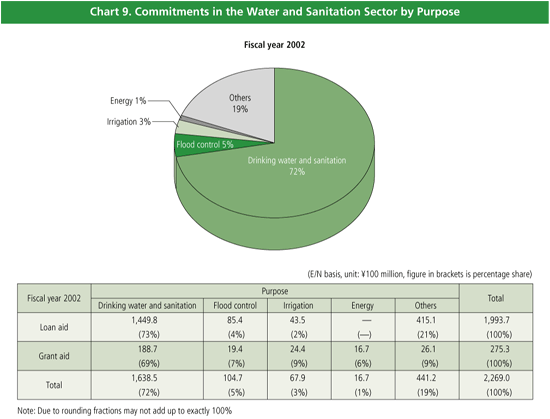 |
Japan has a wide range of purposes in its economic cooperation in the water
and sanitation sector and it is implementing cooperation tailored to the diverse
needs of developing countries. In the Third World Water Forum held in March
2003, Japan announced the “Initiative for Japan’s ODA on Water”
as its major policy for comprehensive contribution to the water sector and is
focusing on the following salient measures under the initiative:
| (1) | Establishment of “Grant Aid for Water Security” of ¥16 billion in the fiscal year 2003 budget |
| (2) | Provision of loan aid on concessional terms (current interest rate of 0.75%) for financial needs, primarily to urban areas in developing countries |
| (3) | Carry out human resources development of approximately 1,000 people over five years beginning in fiscal year 2003 in the field of water supply systems and sewage systems sector. |
Japan is also taking specific actions in this sector through international
partnerships such as Japan-US cooperation, Japan-France cooperation, etc.
Japan’s cooperation in the water sector is implemented with priority on
the drinking water and sanitation sector for which goals were established in
the MDGs and Plan of Implementation at the Johannesburg Summit. Japan provides
a large amount of cooperation in this sector compared to other donors in the
world. According to Organisation for Economic Co-operation and Development-Development
Assistance Committee (OECD-DAC) statistics, over the past three years (1999–2001)
Japan has been the world’s largest donor among the bilateral donors and
international institutions on the drinking water and sanitation sector, providing
approximately $1 billion, one-third of the average (approximately $3 billion)
of the total ODA financial flow.
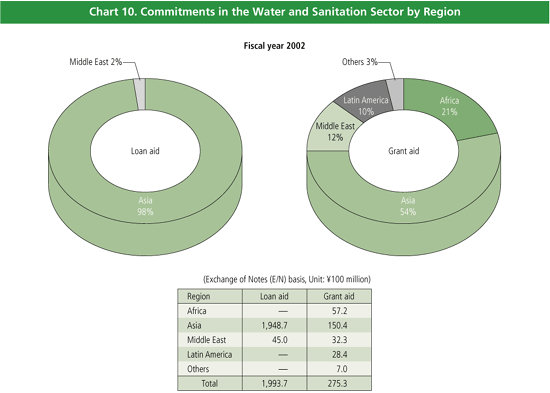 |
Commitments in fiscal year 2002 in the water and sanitation sector, including
both grant aid and loan aid, totaled ¥226.9 billion. This assistance was
provided for the following purposes: drinking water and sanitation, flood control,
irrigation, energy (hydroelectric power), and others (water pollution monitoring,
afforestation, etc.)
Looking at Japan’s disbursements to the water and sanitation sector in
fiscal year 2002 by purpose, drinking water and sanitation occupied approximately
70% of the total and forest planting, etc. came to approximately 20%.
Looking at how the different types of financial assistance were typically used,
approximately 70% of grant aid was provided for the construction of wells and
other water supply facilities and the remainder was used for irrigation, flood
control measures, forest planting, prevention of arsenic contamination of underground
water supplies, etc. On the other hand, approximately 70% of loan aid was provided
for water supply and sewerage systems to improve the environment of the drinking
water and sanitation conditions in urban areas, approximately 20% was provided
for afforestation to prevent desertification, and the remainder was used for
flood control in urban areas.
Looking at commitments by region, nearly all loan aid went to Asia. Asia also
received over 50% of grant aid, followed by Africa with more than 20%.
As an example of financial and technical cooperation, in Bangladesh well water
is contaminated by arsenic in the ground, 60 million people—approximately
50% of the entire population of the country—were being affected by drinking
water containing levels of arsenic exceeding WHO standards, and there were more
than 10,000 suffering from chronic arsenic poisoning. For this reason, through
the “The Project for Mitigation of Arsenic Contamination,” in cooperation
with UNICEF, Japan is providing the grant aid necessary to disseminate information
and knowledge concerning arsenic to the people, carry out surveys of arsenic
levels in wells, ensure alternative water sources, and identify and treat patients.
In Ho Chi Minh City, Viet Nam’s largest city, most of the land area of
the city is low-lying at just two to three meters above sea level while drainage
facilities are inadequate. Consequently flood damage occurs frequently, especially
in the rainy season, and to make matters worse, canals and drainage ditches
are severely polluted by discharged and untreated sewage. For this reason, through
the “Ho Chi Minh City Water Environment Improvement Project,” Japan
is to provide loan aid to strengthen drainage capacity in the central areas
of the city, to prevent and alleviate flood damage, and to improve the urban
environment and sanitation in the lives of people by collecting sewage, developing
treatment facilities and improving water quality in canals. Furthermore, in
Senegal water supply facilities have been developed through grant aid over more
than 20 years. In order to appropriately maintain and manage these facilities,
a system for raising awareness of water supply facility maintenance and management
methods has been developed at some plants which were selected from 109 points.
There Japan is implementing technical cooperation through the “Projet Eau
Potable et Appui aux Activités Communautaires,” with the objective of establishing
operation system water management committee by local residents.
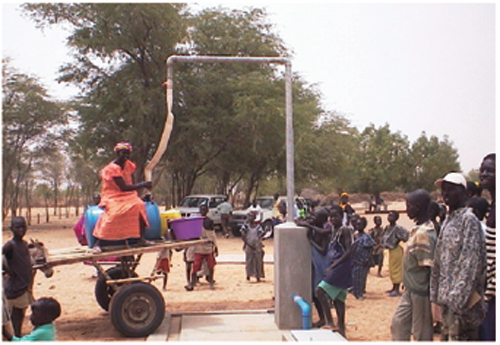 |
| A vehicle water station where people can get water directly from horse-drawn carriages (Senegal) |
2. Refer
to Part I for details.
3. UNDP, Human Development Report 1995
(Gender and human development)
4. Beginning in April 2003 Japan has been
implementing the “Gender Mainstreaming and Policy through Upgrading Information
and Research Capacity” (technical cooperation project)
5. These profiles presented statistics and
indexes in sectors such as population, education, health, family, economic activities,
etc. and attempted to clarify gender issues in each province.
6. Framework for Action on Water and Sanitation
(August 2002), UN Water, Energy, Health, Agriculture and Biodiversity (WEHAB)
Working Group